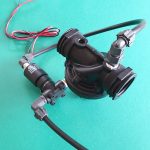Irrigation Solenoid Valve I2C Controller

Solenoid type irrigation valves operate by controlling a small valve that diverts hydraulic pressure available from the water supply to operate the main valve. So a small force controlled by the solenoid is effectively amplified to create a much larger force needed to operate the main valve.
To operate the control valve a short, low voltage, relatively high current pulse is applied to the solenoid. The direction of the current determines whether the solenoid opens or closes, hence opening or closing the main valve. The short electrical pulse has to be just long enough to operate the solenoid without the current having time to heat up and burn out its coil. The short pulse of energy is usually derived by discharging a capacitor through a relay switch, which is a changeover type that can reverse the voltage to open or close the valve.
Rather than using a relay we developed a solid state circuit to pulse the valve on and off. This circuit charges up a 5,600uF capacitor, then allows it to discharge through an H bridge device (DRV8838 from TI) whose output voltage can be reversed. The operation is controlled by an on-board, 8 bit microcontroller that has been programmed to act as an I2C slave device. The controller board (see picture below) can be run from a 3.3 volts power supply that is boosted to provide around 10 volts needed to operate the solenoid.

